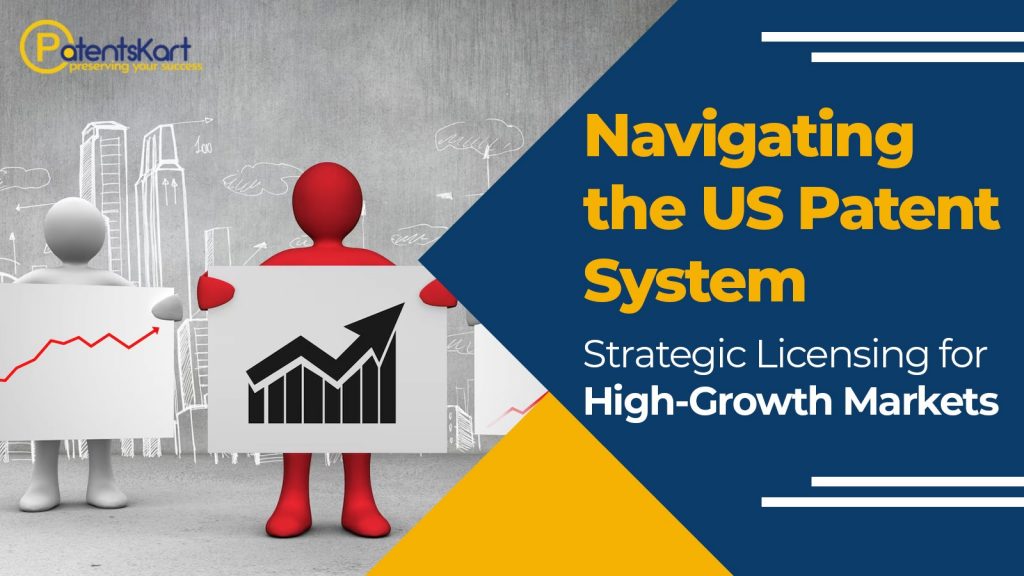The United States patent system is a critical foundation for fostering innovation, providing inventors with the legal protections they need to bring new technologies and ideas to market. However, securing a patent is just the beginning. For companies aiming to thrive in high-growth markets, strategic patent licensing can be a powerful tool to unlock new revenue streams and enhance competitive positioning. This article explores how to effectively navigate the US patent system to optimize patent licensing strategies in these dynamic markets.
Understanding the US Patent System and Its Impact on Licensing
To leverage patents effectively, it’s essential to have a solid grasp of the US patent system. The United States Patent and Trademark Office (USPTO) grants patents that offer inventors exclusive rights to their inventions for a limited time, typically 20 years for utility patents. These rights are granted based on the invention’s novelty, non-obviousness, and utility, which are key criteria in the patent examination process.
Types of Patents and Their Strategic Importance
Understanding the types of patents available is crucial for developing a successful licensing strategy:
- Utility Patents: These cover new and useful processes, machines, articles of manufacture, or compositions of matter. Utility patents are the most common and are particularly valuable in fields like biotechnology, software, and pharmaceuticals, where technological advancements are rapid and continuous.
- Design Patents: These protect the ornamental design of functional items. They are especially important in industries such as consumer electronics, automotive, and fashion, where product appearance can significantly impact market success.
- Plant Patents: These are granted for new and distinct varieties of plants. In agriculture and horticulture, plant patents are vital for protecting new plant varieties that offer improved traits or increased yields.
Strategic Licensing: A Pathway to Expanding Market Presence
In high-growth markets, being able to adapt quickly and capitalize on emerging opportunities is essential. Strategic licensing allows companies to monetize their patents, enter new markets, and expand their product offerings without directly manufacturing or selling products.
Identifying High-Growth Markets
The first step in strategic licensing is identifying high-growth markets where your patented technology could make a significant impact. These markets are characterized by rapid expansion, strong demand for innovation, and substantial investment in new technologies. Examples include sectors like renewable energy, artificial intelligence, biotechnology, and advanced manufacturing.
Aligning Your Patent Portfolio with Market Needs
Once high-growth markets are identified, it’s crucial to align your patent portfolio with the specific needs and trends of these markets. This involves conducting a thorough analysis to determine which patents are most relevant and valuable. Utilizing tools like patent landscaping and AI-driven analytics can provide insights into market trends, competitive activity, and potential gaps where your patents could provide a competitive edge.
Crafting a Strategic Licensing Plan
Developing a strategic licensing plan requires a comprehensive approach that considers both legal and market factors.
Assessing Patent Strength and Enforceability
Before pursuing licensing opportunities, it’s important to evaluate the strength and enforceability of your patents. This includes examining the scope of your claims, the quality of the patent prosecution history, and the likelihood of withstanding legal challenges. A strong, enforceable patent is more attractive to potential licensees and can command higher licensing fees.
Choosing the Right Licensing Model
Selecting the appropriate licensing model is key to aligning with your business goals and market strategy. Here are some common models to consider:
- Exclusive Licensing: Grants a single licensee exclusive rights to the patent, often within a specific geographic area or market. This model can be particularly effective in high-growth markets where the licensee is committed to aggressively commercializing the technology.
- Non-Exclusive Licensing: Allows multiple licensees to use the patent, potentially generating multiple revenue streams. This model is well-suited for technologies with broad applicability across various sectors, promoting widespread adoption.
- Cross-Licensing: Involves exchanging patent rights with another company, often to avoid litigation or access complementary technologies. This can be advantageous in competitive markets with complex IP landscapes, fostering collaboration and mutual benefit.
Structuring Effective Licensing Agreements
A well-structured licensing agreement is essential to protect your IP rights and maximize financial returns. Key elements to consider include:
- Royalty Structures: Determine royalty rates based on the technology’s value, market potential, and the licensee’s capabilities. Consider flexible arrangements like tiered royalties or lump-sum payments to align with market dynamics and incentivize performance.
- Field of Use Restrictions: Clearly define the scope of licensed rights, including geographic limits and specific applications. This helps prevent market cannibalization and ensures your patents are used strategically.
- Enforcement and Infringement Provisions: Include provisions for monitoring compliance and addressing potential infringement. Effective enforcement mechanisms and dispute resolution strategies, such as arbitration or mediation, can help manage conflicts without resorting to litigation.
Leveraging Expertise and Technology in Licensing
Navigating the complexities of the US patent system and executing a successful licensing strategy requires a combination of legal expertise and technological tools.
Harnessing Advanced IP Management Tools
Modern IP management platforms leverage AI and big data to analyze patent portfolios, monitor market trends, and identify potential licensing opportunities. By integrating these tools into your licensing strategy, you can make more informed decisions and streamline the management of your IP assets.
Emerging Trends: Blockchain for Smart Contracts
Blockchain technology is increasingly being explored for patent licensing, particularly for smart contracts. These self-executing contracts automate the enforcement of licensing terms, ensuring that royalty payments are made promptly and reducing the risk of disputes. Incorporating blockchain into patent licensing strategies can enhance transparency, reduce transaction costs, and improve trust among parties.
Staying Informed on Legal and Market Developments
The patent landscape is constantly evolving, with changes in laws, regulations, and market conditions that can impact licensing strategies. Staying informed about these developments is crucial to maintaining a competitive edge. Regular consultations with patent attorneys, participation in industry conferences, and continuous market analysis are essential practices for staying up-to-date.
Actionable Steps for Strategic Licensing
To implement a successful strategic licensing plan, consider the following actionable steps:
- Conduct a Patent Portfolio Audit: Regularly review your portfolio to identify high-value patents and assess their relevance in target markets.
- Engage with Market Experts: Collaborate with industry experts to gain insights into high-growth markets and align your patents with emerging trends.
- Leverage Advanced Tools: Utilize IP management tools and analytics to evaluate patent strength, identify licensing opportunities, and monitor market dynamics.
- Develop a Flexible Licensing Strategy: Tailor your licensing agreements to meet the specific needs of licensees while protecting your IP and maximizing revenue.
- Stay Agile: Continuously monitor legal developments and adjust your strategy to respond to changes in the patent landscape and market conditions.
Conclusion
Navigating the US patent system for strategic licensing in high-growth markets is a sophisticated endeavor that requires a deep understanding of both legal and market dynamics. By carefully analyzing your patent portfolio, aligning it with market needs, and developing a robust licensing strategy, you can unlock new revenue streams and strengthen your market position. Remember, the IP landscape is ever-evolving; staying informed, leveraging the right technologies, and continually reassessing your approach will ensure your patents remain powerful assets driving growth and innovation. For businesses serious about maximizing their IP value, now is the time to evaluate your portfolio and explore new licensing opportunities.
Also Read: Understanding Intellectual Property Rights in the Billion-Dollar Video Games Industry (https://patentskart.com/intellectual-property-rights-in-the-billion-dollar-video-games-industry/)







